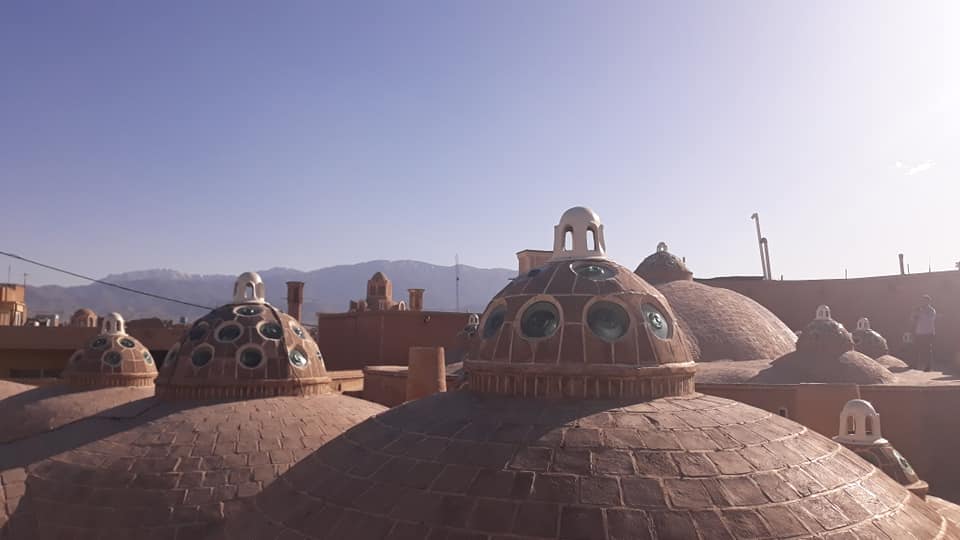KASHAN TRAVEL GUIDE
Things to Do in Kashan – Activities & Attractions
—————————Ο————————

Things to Do in Kashan – Activities & Attractions
—————————Ο————————
Top 6 Places to Visit in Kashan
One of the most important items for every traveler is choosing the best sites among a number of available places to visit. There are a number of historical sites in Kashan, especially some of the most beautiful traditional houses with Iranian architecture.
As a result, the city is one of the most visited one in Iran by both local and traditional visitors. In addition to sites, people visit the city for two festivals every year; the first one is Festival of Rose and Rosewater in May, and the other one is Ashura and Tasua which is a major festival for Shia Muslims who commemorates the martyrdom at Karbala of Hussein, grandson of the Prophet Mohammad.
Tepe Sialk or Sialk Hill is the most historical site in Kashan with a magnificent architecture, which is actually the remains of an ancient city from thousand years ago. It is believed that the oldest settlement in Sialk dates back to more than 7000 years ago.
There are two major hills at Tepe Sialk, apart from each other by half a kilometer, known as cemeteries A and B. According to excavations at the site during the past few decades, it is for sure that there were six main phases of occupation at the place. And the oldest settlement has been identified in the northern hill which belongs to the first half of the fifth millennium BCE.
However, the northern hill was abandoned, at the beginning of the fourth millennium, and according to the evidence, it is believed that the southern hill was occupied, by descendants of people who used to live on the northern hill. It seems that the new settlers leveled the top of the mound, to make space for a large, palace-like residence.
Evidence demonstrates that Tepe Sialk was an important metal production center in central Iran.
Nine gardens in Iran are known as the symbols of the Persian Gardens concept and listed as World Heritage Sites of UNESCO in 2011. Fin Garden with a history of 400 years is one of these gardens which was primarily built by Shah Abbas the first, around the first half of the 16th century.
However, the garden continued to develop since then, especially during the reign of the 2nd Qajar Shah of Iran, Fath-Ali Shah Qajar.
The garden covers an area of 2.3 hectares which is surrounded by a high curtain wall with circular towers, which separates this oasis from the surrounding arid landscape.
One of the most visited and popular monuments at the garden is the Bathhouse. There are actually two bathhouses; the larger one was built during the Qajar period, and the smaller one dates back to the Safavid period. In 1852, the murder of Amir Kabir, the prime minister of Nasar al-din Shah, took place in the small bathhouse.
A number of beautiful historical houses in Kashan are among the top places to visit by any traveler to Kashan. Three major houses in the city are the Boroujerdi House, the Tabatabaie House, the Abbasian House, and Ameri-ha House. There are some common features found in all of these houses. For instance, the material for construction; bricks, mud, and straw for insulation and facade, gypsum for decoration of facade and interior, mirrors for making inner spaces more beautiful, and thick wooden doors for protection.
In addition, the same as all houses in Iran with traditional architecture, all of these houses open to an octagonal room called “Hashti”. Then, there are two main parts at the house: Exterior Section (Biruny), and Interior Section (Andaruny). Moreover, none of these houses have a window looking outside.
Exterior Section (Biruny) is usually larger than the other section, and used for guests and visitors. Interior Section (Andaruny) is a separated part of the house used by the family members. There’s also a section for servants, which usually have its own entrance.
Some of these houses are now used as traditional hotels, so if you are looking for an authentic experience in your trip, overnight at one of these magnificent places could be the best option for you.
This complex is constructed at the heart of Kashan, in the late 18th century, and Agha Bozorg Mosque is known as “the finest Islamic complex in Kashan”.
The most magnificent item about the mosque is its symmetrical design, along with two large iwans, one in front of the mihrab and the other by the entrance. At the main entrance, there is a pair of exquisite wooden doors, decorated with Girih tiles and studs. It is said that there are six thousand and 666 doornails used on the doors, which is the number of verses of the Holy Quran.
The buildings of the mosque and school of Agha Bozorg were registered in the list of Iran’s national monuments in 1951.
Being one of the oldest cities in the country, the traditional bazaar of Kashan has a history behind. It is believed that the building was constructed for the first time during the Seljuk era, and later renovated during the Safavid period. The site has been the center of trade in Kashan for almost 800 years.
It has an interesting architecture, with a famous Timche-ye Amin od-Dowleh section, and multi-domed roof which was built in the 19th century.
There are also a number of orders in the bazaar, each for a particular product. For instance, coppersmiths, goldsmiths, shoemakers, mercers.

The roof of the bathhouse is made of multiple domes that contain convex glasses to provide sufficient lighting to the bathhouse while concealing it from the outside.